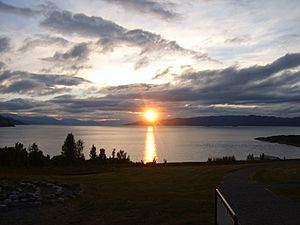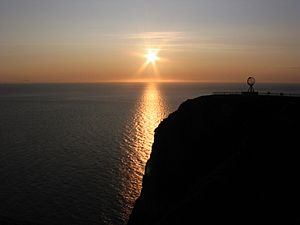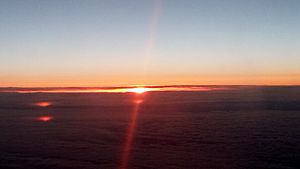Midnight sun facts for kids
The midnight sun is a cool natural event that happens in summer in places far north of the Arctic Circle or far south of the Antarctic Circle. It means the Sun stays visible all night long, even at local midnight!
Contents
What is the Midnight Sun?
Around the summer solstice (which is about June 21st in the Northern Hemisphere and December 22nd in the Southern Hemisphere), the Sun can be seen for a full 24 hours if the weather is clear. The closer you get to the North or South Pole, the more days you'll see the midnight sun.
Even though it's mainly seen inside the polar circles, you can sometimes spot the midnight sun up to 55 miles (90 km) outside these circles. This is because of how light bends in the air and because the Sun is a big disc, not just a tiny point.
Where Can You See It?
Since there aren't many people living south of the Antarctic Circle (only research stations), most people who experience the midnight sun live in places crossed by the Arctic Circle. These include:
- Parts of Canada (like Yukon, Nunavut, and Northwest Territories)
- Iceland
- Finland
- Norway
- Sweden
- Denmark (specifically Greenland)
- Russia
- The state of Alaska in the United States
In Finland, a quarter of the country is north of the Arctic Circle. At its northernmost point, the Sun doesn't set for 60 days in summer! In Svalbard, Norway, which is the northernmost place in Europe where people live, the Sun stays up from about April 19th to August 23rd.
At the very top and bottom of the Earth (the North and South Poles), the Sun can be seen all the time for half of the year! The North Pole has midnight sun for six months, from late March to late September.
What About the Opposite?
The opposite of the midnight sun is called polar night. This happens in winter when the Sun stays below the horizon all day long. So, it's dark all the time!
Why Does the Midnight Sun Happen?
The Earth is tilted on its axis by about 23.5 degrees. Because of this tilt, during summer in the far north or far south, the Sun never dips below the horizon. It just keeps circling around in the sky.
At the poles themselves, the Sun rises and sets only once a year, during the equinox. For the six months the Sun is above the horizon, it continuously moves in circles around you, slowly getting higher until it reaches its highest point at the summer solstice.
Even places slightly south of the Arctic Circle, like most of Iceland (except for Grímsey), are famous for their midnight sun. This is because of how light bends in the atmosphere. For the same reason, the period of sunlight at the poles is a bit longer than six months. Even the northern parts of Scotland and places like St. Petersburg in Russia have bright twilight all night long around the summer solstice.
Time Zones and the Midnight Sun
Sometimes, people talk about the "midnight sun" when the Sun sets very late, like after midnight. This can happen even in places slightly south of the Arctic Circle, like Fairbanks, Alaska. This isn't the true midnight sun (where it never sets), but it's because of how time zones and daylight saving time work.
For example, in Fairbanks, the Sun might set at 12:47 AM during the summer solstice. This is because Fairbanks' clock time is a bit ahead of its natural solar time, and they also use daylight saving time. So, the Sun's highest point in the sky happens later than noon on the clock.
The real "midnight sun" means the Sun is still visible when it's at its lowest point in the sky, usually when it's due north of you. This doesn't always happen exactly at midnight on the clock because of time zones and how the Earth moves around the Sun.
White Nights
In some places, the Sun doesn't set completely, but it also doesn't stay fully visible. Instead, it stays just below the horizon, creating a bright twilight all night long. This is called "white nights." You can still do things like read without needing artificial lights on a clear night.
White Nights are a famous symbol of Saint Petersburg, Russia. They happen there from about June 11th to July 2nd. The last 10 days of June are celebrated with special cultural events called the White Nights Festival.
How Long Does it Last?
At the Arctic Circle, the midnight sun is visible for about two weeks, from June 12th to July 1st. But as you travel further north, this period gets much longer:
- At Cape Nordkinn, Norway, the northernmost point of mainland Europe, the midnight sun lasts from about May 14th to July 29th.
- On the Svalbard islands, even further north, it lasts from April 20th to August 22nd.
Images for kids
-
A summer night in the city of Pori, Finland, on July 2, 2010.
See also
 In Spanish: Sol de medianoche para niños
In Spanish: Sol de medianoche para niños






